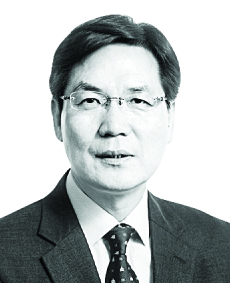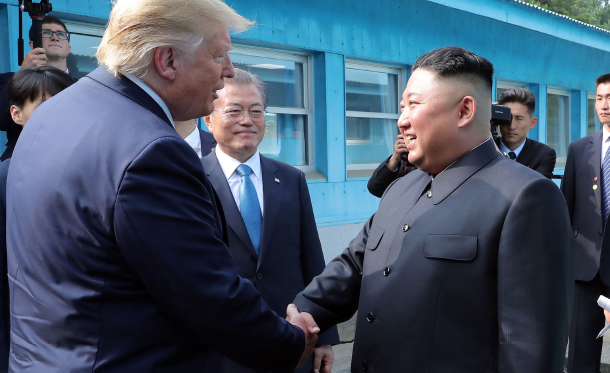Kim’s difficult position

The author is a senior researcher at the Military and Security Research Center of the JoongAng Ilbo.
It was June 1953 and cease-fire negotiations were going nowhere. Chinese Communist Army troops landed in Gimhwa County, Gangwon, on the order of Mao Zedong, who proclaimed to postpone the signing of the 1950-53 Korean War Armistice Agreement and demanded the killing of 15,000 South Korean soldiers. Peng Dehuai, then-commander of the Chinese People’s Volunteer Army, arrived in Pyongyang on June 20, all set to wrap up the agreement after irreversibly defeating South Korea in the war.
On July 10, the Chinese forces mobilized 15 divisions to attack six South Korean divisions in what is known today as the Battle of Kumsong, the last battle of the Korean War. The battle was fierce. South Korea’s then-Army chief of staff Paik Sun-yup recalls that moment as the “biggest crisis” of the Korean War. China, at the time, intended to put pressure on Syngman Rhee, who was against signing the agreement. But in the larger picture, China was vying to unify the Korean Peninsula under communist rule. In the end, the battle caused about 14,000 casualties on the South’s side, including 1,701 deaths, and 66,000 Chinese Army casualties, including 27,000 deaths.
The new coronavirus from Wuhan, which is now killing more than 200 people each day, is undermining the security of the peninsula. North Korean leader Kim Jong-un and South Korean President Moon Jae-in have both already been affected. Kim was already struggling with an economic crisis due to international sanctions, and now he can’t go anywhere amid fears of infection. Moon tried to revive inter-Korean ties this year by allowing South Koreans to individually tour the North, but that idea went down the drain with the new coronavirus outbreak. More Chinese people are turning against their leader, President Xi Jinping, blaming him for failing to take early preventive measures against the disease. If the growing public dissent shifts toward the rigidity of Xi’s monolithic rule and people demand human rights and freedom, China’s political system will become more instable.
President Moon is also in a predicament. In his Jan. 14 New Year’s press conference, Moon vowed to resume the North Korean denuclearization talks and restore inter-Korean relations, in part by allowing South Koreans to take individual tours to the North through a third country, like China, and by organizing reunions of families separated by the Korean War and improving the North’s old railways and roads. But North Korea shut down its borders and banned traffic between China, which means allowing individual tours to North Korea is off the table for the time being.
Moon had hoped to invite Xi to Seoul in March to help create the mood for a third summit between Kim and U.S. President Donald Trump. But Xi apparently won’t make the move next month now that he’s busy dealing with the outbreak of the lethal virus. Trump, on the other hand, is in presidential campaign mode. He reportedly said that he has no intentions to meet Kim before the November election. Without another U.S.-North summit, denuclearization negotiations will make no progress and international sanctions will remain in place, while South Korea will find it difficult to provide aid packages to the North. In other words, the novel coronavirus is undercutting Moon’s efforts to improve ties with Pyongyang and help put the denuclearization talks back on track. The outbreak is also detrimental to the ruling Democratic Party ahead of the April 15 parliamentary elections in South Korea.
Kim Jong-un is faring no better. As dialogue with Washington was at loggerheads late last year, Kim declared to seek “a new path” by launching an offensive for a “frontal breakthrough” during a plenary meeting of the ruling Workers’ Party. Kim vowed not to re-engage in denuclearization talks unless sanctions were lifted. But Washington is losing momentum to engage in talks anyway. Many U.S. officials who dealt with North Korea in the National Security Council, Department of State and Department of Defense — including U.S. special envoy for North Korea Mark Lambert — have all quit. Washington’s North Korea negotiation team is effectively on the verge of disbanding. Unless Kim gives up his nuclear weapons without any preconditions, Trump will not want to hold a summit with him again. Kim, on the other hand, has no reason to denuclearize without anything in return.
Pyongyang’s frontal breakthrough strategy means the regime will pursue self-reliance while mass-producing and advancing its nuclear and missile weapons to counter Washington. But the strategy raises economic and military risks. For one, sanctions applied by the United States and the United Nations over the past three years have taken a serious toll on North Korea’s economy. With sources of foreign currency cut off, Pyongyang is expected to burn through its reserves.

North Korean leader Kim Jong-un, right, shakes hands with U.S. President Donald Trump on June 30, 2019, before a hurriedly-arranged summit in Panmunjom. [YONHAP]
There are also military risks. North Korea’s nuclear and missile buildup may empower Kim’s authority at the moment but will not, eventually. At a pace like this, Pyongyang is expected to secure as many as 100 nuclear warheads by the end of 2020. The problem is, when the regime has far too many warheads, denuclearization becomes impossible.
That’s why there’s a high possibility that Washington will try to alter its North Korea stance next year under its new administration. Instead of maintaining Trump’s dialogue strategy, the United States may focus more on adding pressure on the regime. If Pyongyang responds by firing an intercontinental ballistic missile, Washington, in turn, will not sit by and watch.
Pyongyang has a history of provoking Seoul in times of difficulty. The vicious cycle has always gone from confrontation to negotiation and reconciliation, and back to square one. Now that Kim has nuclear weapons, North Korea will be able to threaten the South on much higher grounds. That’s why if Kim decides to raise tensions this year as part of his frontal breakthrough campaign, it may not stop at a local conventional war. Instead, the North might alarm the South by threatening a nuclear attack, or send South Korea into chaos with a large-scale offensive cyber operation.
The problem is that the liberal Moon administration believes our troops will give a Pavlovian response to a North Korean provocation. Without unreasonable instructions from the Blue House or the military leadership calling for self-restraint, rank-and-file soldiers would automatically fight back in accordance with their operational plan. Defense Minister Jeong Kyeong-doo said South Korea was capable of paralyzing the North Korean command in two to three days with fighter jets and missiles.
However, a nuclear threat is a whole different level — and Seoul does not have countermeasures against it. It is time for the United States to step up. The B61 nuclear bomb and W76-2 low-yield nuclear warhead are the kernels of America’s nuclear umbrella capable of containing North Korean nuclear weapons. The former is used in the U.S. Air Force, and the latter was recently deployed aboard the Ohio-class USS Tennessee ballistic missile submarine. These two conventional nuclear weapons can effectively destroy the North Korean command’s underground bunker.
The B61-class nuclear bombs can be carried onto fighter jets and airdropped onto enemy zones. The mission takes more than three hours when the jets take off from Guam or Okinawa, Japan. A W76-2 nuclear weapon, on the other hand, can travel at speeds of up to Mach 24 when fired from a submarine and target anywhere on Earth within half an hour. North Korea’s command center would be annihilated in no time. Seoul and Washington should seriously discuss how the allies can use tactical nuclear weapons to contain Pyongyang’s nuclear weapons, apply any agreements to their allied operational plan and commence combined training operations. This year marks the 70th anniversary of the outbreak of the Korean War. Our military and government must not forget the Battle of Kumsong and prepare for the worst.










with the Korea JoongAng Daily
To write comments, please log in to one of the accounts.
Standards Board Policy (0/250자)